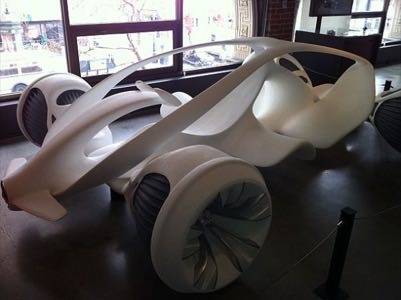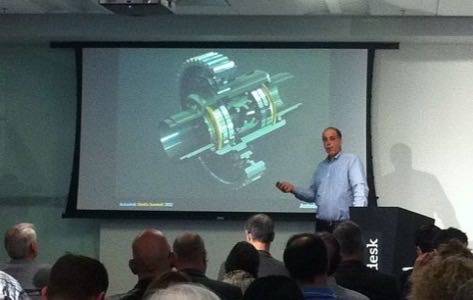
Most people think of Autodesk as the maker of AutoCAD, the design software of choice for architects, engineers and other design professionals – typically running on high-powered workstations. So why is Autodesk CEO Carl Bass so hung up on the “democratization” of technology – spreading technology to the cloud computing platforms and mobile devices?

At the company’s media summit in San Francisco this morning, Bass told a crowd of journalists, analysts and customers gathered in the company’s slick design gallery (see pictures below) that the combination of mobile devices, cloud computing and social collaboration is more profound than the shift to PCs.
Tomorrow in ReadWriteCloud: More on Autodesk’s cloud-based PLM (Product Lifecycle Management) offering
Five years ago, no matter what size company you worked for, most likely you’d come to the office and sit down at your Windows PC (with some Macs), connect to the LAN, with storage on Z drives and some sort of attached storage.
Bass sees the world changing from a PC-centric model where workers promise to “email you that file when I get back to the office,” to an environment where mobile devices and the cloud make where ever you are the computing center of the world.

It’s already happening, he claimed, citing a list of impressive usage figures:
- 2 million unique visitors a month to Autodesk 360, the company’s cloud offering
- 30 files a minute uploaded to AutoCAD WS, the company’s cloud-based AutoCAD editor
- 10 million downloads of SketchBook in 2 years, now averaging 150,000 per week on PC and mobile platforms
- 13 million unique visitors – more than Pinterest – to the company’s Instructables community
- 21 million unique visitors a month to Pixlr, its online photo editor
On the low end, naysayers like to denigrate the importance of mobile products, Bass said, calling them “juvenile” “toys.” But he pointed out that “consumers by night are often professionals by day.”
He also claimed that professionals can do serious work on today’s portable devices. “I think we’re underestimating these small devices… in the work that we do. They can run serious apps” for engineers and other demanding users, and they are getting more powerful all the time.
Meanwhile, on the high end, the cloud lets anyone take advantage of analyses that used to require dedicating expensive workstations for days at a time. Now, “You can do it in the cloud in an hour,” he said.
The cloud, Bass added, “is an infinitely scalable resource,” limited only by how much you’re willing to pay. For urgent jobs, you can pay more and get it done faster. Other tasks can be done more cheaply over time. And that raises a fundamental question: “What would you do differently if you could compute answers faster?”
Autodesk may be a bit ahead of its time. The vast majority of serious design work is still being done sitting at powerful workstations, just as it has been for a while. But Bass couldn’t be more correct about the trends. It’s hard to argue that more and more computing tasks are going to stop moving away from the desktop. Big, data intensive jobs will move to the cloud while smaller, more UI-focused tasks are going mobile.
There will always be some things best done sitting at your computer. But the number of those things is clearly shrinking, not growing.
Tomorrow, I’ll write about Autodesk’s cloud-based PLM (Product Lifecycle Management) offering. But in the meantime, enjoy a couple more shots of some of the cool designs on display in the Autodesk Gallery:


















